|
Sorrento
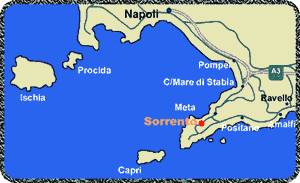
A
town with 20.000 inhabitants, it was built on a high tuff ridge
overlooking the wonderful Gulf of Naples, and loved by poets and
writers for its gardens and marvellous sunsets. It was here that
Ulysses resisted the tempting chants of the mermaids, asking his
crew to tie him to the mast of his ship while they had their hear
sealed with wax. This is also the birth town of the poet Torquato
Tasso, author of "Gerusalemme liberata" ("Jerusalem delivered")
Although it is only a small town, Sorrento counts more than 100
hotels and it is the destination of more than 2 and half million
visitors a year. As a matter of fact, it considered being a central
place from where the most important places of the area can easily
be reached by means of public transportation. Sorrento is also renown
as manufacturing place of inlayed woodworks and embroidery.
You
can reach the places below in about...
| Capri |
7
miles |
20 minutes
by hydrofoil one hour by ferry boat |
| Napoli
o Salerno |
50
Km |
one
hour by car |
| Roma |
250
Km |
three
and a half hours by car |
| Pompei |
30
Km |
40 minutex
by car |
| Ercolano |
42
Km |
one
hour by car |
| Vesuvio |
50
Km |
one
and a half hours by car |
| Positano |
16
Km |
half
hour by car |
| Amalfi |
34
Km |
one
hour by car |
| Ravello |
43
Km |
one
hour and 20 minutes by car |
| Paestum |
100
Km |
two
hours via highway, three hours via Amalfi coast drive
|
Excursions
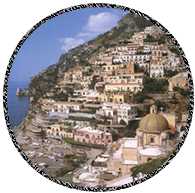 Amalfi
Coast (Positano, Amalfi, Ravello). Amalfi
Coast (Positano, Amalfi, Ravello).
The Amalfi coast
drive is an enchanting road that starts in Meta di Sorrento and
ends in Salerno, after roughly 50 km and more than 1000 winding
curves. Positano, suddenly appearing behind a headland, is the first
village we encounter. Looking at it is like beholding a crib built
on the rocks. Along the little roads and stairways of this village
one can find the distinctive little clothing shops that make Positano's
fashion world wide renowned. 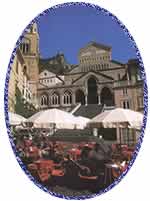
A few kilometres after leaving Positano, we find Hotel S. Pietro,
one of world's most exclusive places. From here it is possible to
see Capri and the Faraglioni.
Next we cross the small village of Praiano, with its centerpoint
the church of S. Gennaro with its magnificent ceramic dome. A little
further, right after the two fishermen villages of Marina di Praia
and Furore we reach the Grotta dello Smeraldo (Emerald's Cave).
There in the seabed, a ceramic crib has been placed. After 20 more
minutes of traveling we arrive in Amalfi, where the majestic cathedral,
built in the IX century and the Cloister of Paradise built in 1266
A.D. can be visited.
Side to side with Amalfi is the little town of Atrani, considered
to be among the smallest 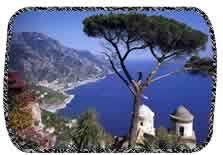 towns
in Italy. towns
in Italy.
A 20 minutes drive away is Ravello. Located at 350 meters above
sea level,
it is practically a balcony on the Gulf of Salerno. Villa Rufolo
is the place where on May 26 1880 R. Wagner found his magic garden
of Klingsor and the inspiration for the second act of the Parsifal.
Villa Cimbrone, the other stunning villa of Ravello, is famous for
its breathtaking panorama, which the American writer and honorary
citizen Gore Vidal defined as the most beautiful in the world. In
town there are a number of small restaurants where hand made pasta
and dozens of other local specialties can be enjoyed. The local
vine (without preservatives) and the homemade Limoncello (a typical
lemon liquor) are among the local specialties.
Pompeii,
Vesuvius...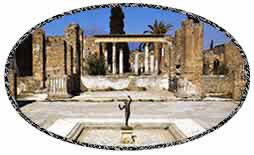
Pompeii was
a 20.000 inhabitant strong city when it was completely buried in
the ashes of the Vesuvius. The Vesuvius had been considered to be
an extinct volcano for many centuries. Vineyards and luxurious houses
covered its slopes when, on 24th August 79 A.D. at noon the volcano
restarted its activity, exploding with a ferocious roar. Other "minor"
archaeological sites such as Cuma, Baia, Bacoli, Miseno, Piscina
Mirabilis, Pozzuoli, the solfatara volcano, the volcanic lakes of
Lucrino, Fusaro, D'averno, Capo Miseno, the museum of Boscoreale,
Stabia, etc are also worth a visit. These places, frequently visited
by archaeologists, might represent an alternative for those who
are already familiar with Pompeii and found of the archaeological
sites. It is also possible to visit the Vesuvius' crater (1280 meters
of altitude) and from there enjoy a marvellous view of the Gulf
of Naples.
...Herculaneum,
Oplontis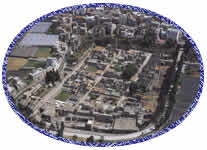
Just
as 2000 years ago the city of Herculaneum was destroyed because,
like Pompeii, it was to close to the Vesuvius, nowadays it lacks
somewhat appreciation because it is to close to the more famous
Pompeii. As a matter of fact, Erakleion (that is its ancient name)
has nothing to envy to her larger neighbour city. Although smaller
(only a third the size of Pompeii), Herculaneum was the preferred
place by the rich Romans and the nobles, who built here their sumptuous
villas Oplonti is a marvellous out-of-town Villa, that is said to
have belonged to Poppea, Nero's wife. This, however, has never been
officially documented. Very well kept and rich with frescos, Oplonti
is only 2 kilometres far from Pompeii.
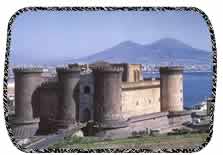 Naples Naples
In
spite of its bad reputation, Naples is one of most beautiful and
interesting cities in Italy. In its National Archaeological Museum
it is possible to admire findings coming from Pompeii, Herculaneum,
Stabia, Cuma, and other places of the region. The Royal Palace in
Piazza Plebiscito houses exhibits of ancient furniture, paintings,
sculptures, tapestry, frescos and porcelain from the
18th and 20th century. Also here is the National Library. Next to
it we find the Royal Theatre of San Carlo and straight in front
of it the gallery Umberto I.
The royal palace at Capodimonte, houses a museum with an exposition
of precious porcelains and also different art galleries. On the
first floor one can admire in the historical apartments expositions
of painters and sculptors from the Neapolitan school (18th century),
while on the second floor paintings are exposed of famous artists
like S. martini, S. Botticelli, Il Perugino. About 120 hectares
of shady woods surrounds the palace. Here also resides the famous
porcelain factory. In the Charterhouse of S. Martin, a 13th century
monastery, there are yet more expositions of paintings, not to mention
the marvellous cribs collection and a panoramic lookout. In the
villa Pignatelli Cortes, one can admire the ancient royal carriages.
More than 100 are the churches that can be visited in Naples. Among
those is the famous Church of S. Gennaro, where every year a miracle
is performed:
the liquefaction of the relic blood of the saint. Also worthwhile
are: a visit to the monastery of S. Chiara, to S. Domenico Maggiore, the S. Severo chapel. In Naples we also
find many nice castles. The Maschio Angioino or Castel Nuovo, Castel
dell'Ovo, Castel S. Elmo. Further there are marvellous fountains,
roads, squares and catacombs of the "Subterranean Naples", not very
well known, but extremely fascinating. The harbour near the maschio
Angioino was built during the periods of great emigrations, and
has become nowadays a mandatory stop for all cruise ships crossing
the Mediterranean Sea. The promenade, from where the whole gulf
of Naples with the Vesuvius, Sorrento and Capri can be viewed, stretches
from Mergellina to the centre of the city for about 3 kilometres.
In the squares we can enjoy the sfogliatella, the babā, or the pastiera,
traditional Neapolitan sweets that everybody has in vain tried to
imitate
first try and then trust!
to S. Domenico Maggiore, the S. Severo chapel. In Naples we also
find many nice castles. The Maschio Angioino or Castel Nuovo, Castel
dell'Ovo, Castel S. Elmo. Further there are marvellous fountains,
roads, squares and catacombs of the "Subterranean Naples", not very
well known, but extremely fascinating. The harbour near the maschio
Angioino was built during the periods of great emigrations, and
has become nowadays a mandatory stop for all cruise ships crossing
the Mediterranean Sea. The promenade, from where the whole gulf
of Naples with the Vesuvius, Sorrento and Capri can be viewed, stretches
from Mergellina to the centre of the city for about 3 kilometres.
In the squares we can enjoy the sfogliatella, the babā, or the pastiera,
traditional Neapolitan sweets that everybody has in vain tried to
imitate
first try and then trust!
Paestum
and Velia
Paestum was
built in the 46th century B.C. by settlers coming from Sibari, the
Achei, who also had built the colony of Poseidonia on the estuary
of the river Sele.
Within one century the city developed so much that it became one
of the most important harbours of the west Mediterranean sea. 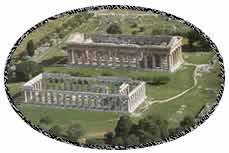 It was during that period that the three temples of Cerere, Hera
and Neptune were built. These temples can still be seen today. After
many misfortunes, the city fell pray of the Roman Empire and was
renamed Paestum. The nearby museum houses findings coming from the
city ad its surroundings. Also plates originating from the tomb
of the diver from about 490 B.C. are kept there. These represent
the only examples of murals from the Magna Graecia. Here you can
taste the best buffalo mozzarella in the region and even see how
it is made. Velia was built in 540 B.C. on the estuary of the river
Alento. Also Velia (or Elea) became an important harbour in the
ancient days. Within the boundaries of the city protected by majestic
walls and with splendidly well kept pavements, it is possible to
admire the famous Porta Rosa with its lancet arch built in 350 B.C.
that is considered the most ancient and better preserved example
of Greek architecture.
It was during that period that the three temples of Cerere, Hera
and Neptune were built. These temples can still be seen today. After
many misfortunes, the city fell pray of the Roman Empire and was
renamed Paestum. The nearby museum houses findings coming from the
city ad its surroundings. Also plates originating from the tomb
of the diver from about 490 B.C. are kept there. These represent
the only examples of murals from the Magna Graecia. Here you can
taste the best buffalo mozzarella in the region and even see how
it is made. Velia was built in 540 B.C. on the estuary of the river
Alento. Also Velia (or Elea) became an important harbour in the
ancient days. Within the boundaries of the city protected by majestic
walls and with splendidly well kept pavements, it is possible to
admire the famous Porta Rosa with its lancet arch built in 350 B.C.
that is considered the most ancient and better preserved example
of Greek architecture.
Caserta
The building
of the royal Palace of Caserta started by Luigi Vanvitelli during
the second half of the 17th century (under the rule of Carlo III
of Bourbon) was finished by Vanvitelli's son Carlo during the reign
of Ferdinand IV. It is a majestic work that had to compete with
the French Versailles. Five storeys on an area of 50.000 square
meters, it has 1742 windows and 1200 rooms, a park that stretches
for 120 hectares, with fountains and basins creating spectacular
water plays and a waterfall 78 meters high. Remarkable is also the
English garden with its 25 hectares of exotic plants and centuries
old trees.
|

